When other gardeners ask how I amend my soil, the answer is almost always with compost tea.
Compost tea is a safe and natural fertilizer that revives and replenishes the soil food web, a highly complex ecosystem comprising a community of good and bad bacteria, fungi, protozoa, nematodes, earthworms, and arthropods.
To put it simply, the soil food web forms the foundation of your plants, and subsequently your food.
Above ground, compost tea envelops your plants in a protective “web” (or biofilm) of living microorganisms that helps reduce foliar diseases and increase the intake of nutrients.
For several seasons, I was brewing my own tea using the compost from my garden (like the castings from my worm bin or the black gold from my compost heap) and any number of add-ins: kelp meal, fish emulsion, fish hydrolysate, blackstrap molasses. A single brewing session almost looked like a science experiment!
And if you turn to the many sources online touting the “right” way to make compost tea, you would find more opinions and suggestions than you could ever try in a growing season.
In all honesty, brewing a batch of compost tea isn’t that tricky. I found that as long as I followed a few basic principles, like proper aeration and dilution, it was hard to mess up… but there could always be a better way.

Types of Compost Tea
Compost tea is a relatively nascent science, and there are endless variables when you take into account the quality of your compost, the makeup of your soil, and the plants growing in your garden.
A compost tea brewed from vermicompost, for example, might be bacterially dominant if you feed your worms more nitrogen (vegetable scraps) than carbon (shredded paper). Bacterial-dominated teas are ideal for vegetables, herbs, grasses, and annuals, which prefer more bacterial soil.
On the other hand, trees, shrubs, and perennials prefer more fungal soil, which is what’s typically found in a forest. The natural mulch formed by decomposing leaves creates a fungal environment for broadleaf and coniferous trees.
At home, fungal-dominated compost tea can be brewed from leaf mold or compost based heavily on brown materials, such as straw, sawdust, or wood chips.
Berries fall right in the middle, preferring a balanced compost tea that’s equally bacterial and fungal. The exceptions are blueberries, grapes, and other acid-loving plants, which thrive in fungal-dominated soil.
| Type of Plant | Type of Compost Tea |
| Brassicas | Highly bacterial |
| Herbs, vegetables, other annuals | Moderately bacterial |
| Berries | Bacterial and fungal |
| Broadleaf trees, shrubs, vines | Moderately fungal |
| Coniferous trees | Highly fungal |
You can also manipulate your compost tea to be more bacterial or fungal by adding specific ingredients to feed the microbes in your brew.
| Ingredient | Feeds |
| Blackstrap molasses | Bacteria |
| Maple syrup | Bacteria |
| White sugar | Bacteria |
| Cane sugar | Bacteria |
| Fruit juice | Bacteria |
| Fish emulsion | Bacteria |
| Kelp meal | Bacteria and fungi |
| Rock dust | Bacteria and fungi |
| Humic acid | Bacteria and fungi |
| Oats | Fungi |
| Fruit pulp | Fungi |
| Fish hydrolysate | Fungi |
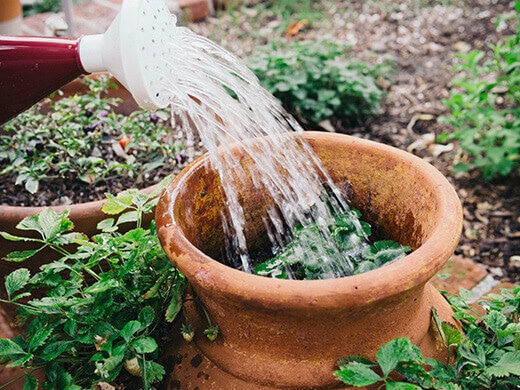
For most of us edible gardeners, a bacterial-dominated compost tea serves us well. It’s also the ideal type of tea for making a foliar spray, as the bacteria work to suppress foliar diseases regardless of the type of plant.
But don’t write off fungi just yet. Below the surface, fungi form a symbiotic relationship (known as mycorrhizae) with plant roots, helping them absorb nutrients and boosting their defenses against soilborne pathogens. They’re an important part of maintaining plant health and do the work we never see.
All said, a well rounded compost tea should host a diverse and thriving community of bacteria, fungi, and other microorganisms, but let’s face it: not a lot of us have the time or resources to be futzing around with compost tea.
How to Brew Compost Tea Without Your Own Compost
Even with several compost heaps happening around the yard, my compost never goes very far. We usually sift it in spring and if we’re lucky, we’ll have enough to spread over a few small beds. The rest of the year, we’re waiting for our compost to break down before we can use it again.
Compost tea helps you get more mileage out of your compost. Even if you don’t compost, you can make compost tea!
Disclosure: If you shop from my article or make a purchase through one of my links, I may receive commissions on some of the products I recommend.
A few months ago, Boogie Brew sent me a box of samples from their product line to try, and I’ve been using their compost tea all season long with impressive results.
My fruit trees are exploding with citrus and my herb beds are lush and green. My broccoli plants, 18 months and going on strong, are still sprouting delicious greens with not a single pest in sight. Dozens of seedlings went from my windowsill to my raised bed in only a week without any transplant shock.
The simplicity of the whole process makes it possible to brew a new batch of compost tea every week with very little effort.
Rather than concocting your own recipe, you can use Boogie Brew’s Heavy Harvest formula, which they bill as a “superb soil vitalizer and biological tonic.” The founder, Josh Cunnings, knows his stuff. He can talk soil biology all day long and truthfully, most of it goes over my head but there’s no denying his knowledge and passion for the subject.
There are three things I especially like about Boogie Brew.
One, it’s a Northern California company run by Josh and his wife out of a small warehouse. They’re a homegrown business dedicated to helping home gardeners.
Two, they supply many a marijuana grower and thus their focus is maximizing plant growth and flower production. Lots of flowers, whether on weed or on tomatoes, are a good thing!
And three, they put together a Boogie Brew Compost Tea Kit containing everything you need to successfully brew your own compost tea.
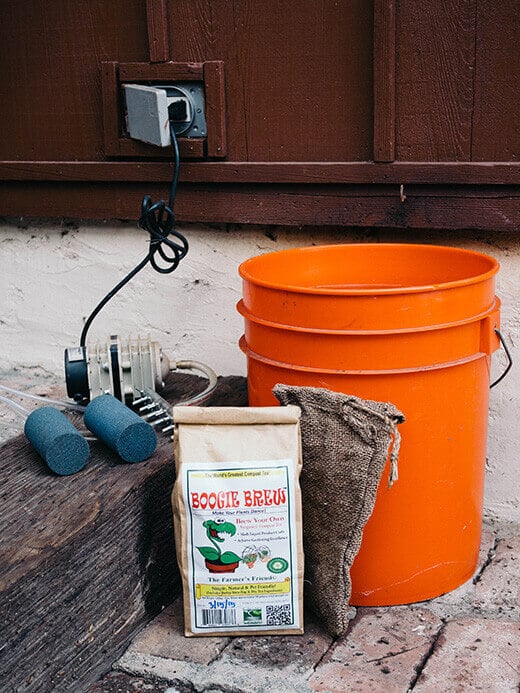
The star of the Brew Kit is Boogie Brew Tea, a fermented blend of premium biodynamic humus, high-chitinase quality worm castings, rock phosphate, langbeneite, kelp, soy and alfalfa meals, North Atlantic kelp extract, nutritional yeast, organic trace sea minerals and volcanic rock powder, humic acid (95 percent purity) from leonardite shale, and organic evaporated cane juice crystals.
It’s a balanced blend of high quality fertilizers and soil conditioners, and Josh personally sources all of the ingredients from trusted suppliers in the United States.
You can further fortify the Boogie Brew Tea with other nutrients, like Boogie Black (an insect frass fertilizer derived from black soldier fly larvae), but the original formula is a powerhouse on its own.
Dechlorinate Your Water
Before you start brewing your tea and showering your garden, it’s worth noting that if you use a municipal water source, you likely have chlorine in your water. It’s added to kill bacteria and keep the water clean, but this means it also kills good bacteria.
Always use dechlorinated water when brewing compost tea. I take it a step further and use dechlorinated water to drench my soil. After all, if I’m adding all these beneficial microbes to the soil, I certainly don’t want to kill them when I irrigate my garden.
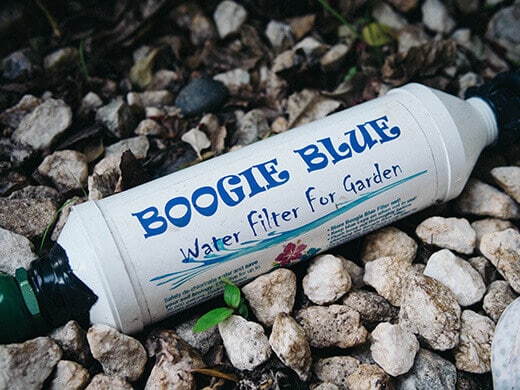
I have the Boogie Blue Water Filter attached to three of the taps in my garden, so that all my hose water and drip irrigation water is dechlorinated. The water filter is included in this bundle with their Boogie Black and I highly recommend it.
Start Brewing
To make actively aerated compost tea (AACT), you’ll need a 5-gallon bucket, a commercial-grade air pump (with an output of at least 45 liters per minute) with a set of air stones, and Boogie Brew Tea. You’ll also need an outlet where you can run your pump overnight out of direct sunlight.
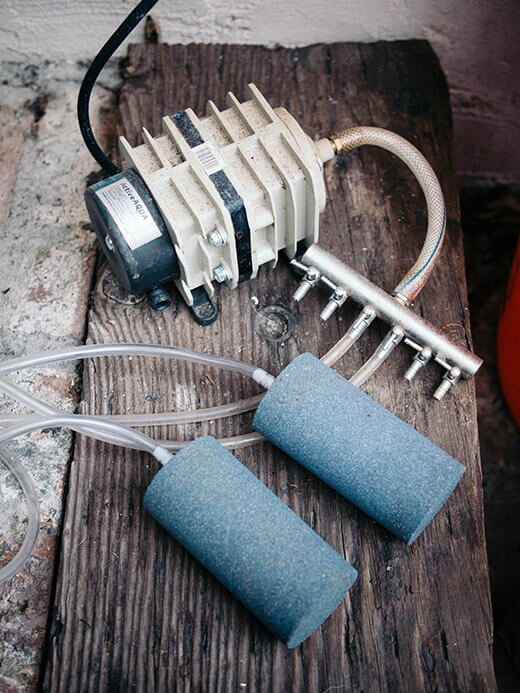
Start with a clean bucket; you don’t want any debris or old bacteria lingering in it. Fill it a couple of inches from the top with dechlorinated water.

Every bag of Boogie Brew Tea comes with a reusable burlap sack. Place one of the air stones into the sack, then add a cup of Boogie Brew Tea and cinch the sack tight.
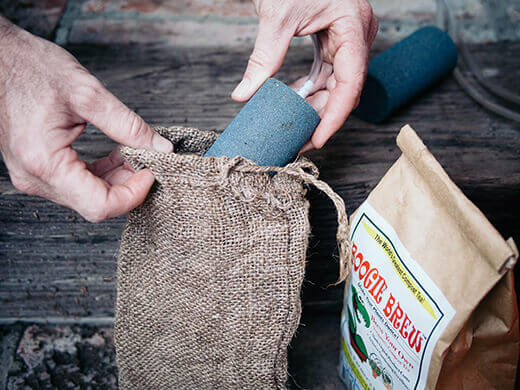

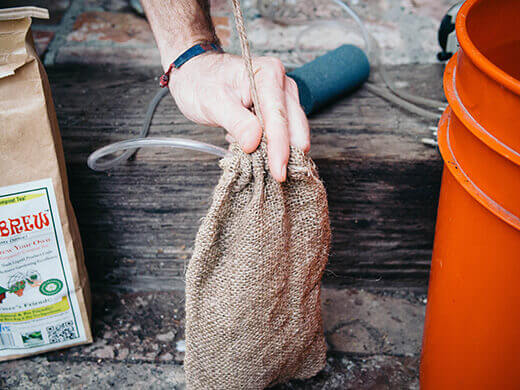
Place the other air stone in the bucket of water and turn on the pump. Drop the burlap sack into the water and let it bubble away.
(You’ll notice that I hang my sack from a small hook on the wall. This isn’t necessary but since I don’t strain my tea, I find that it helps keep the larger particulates from escaping while the tea is aerating.)



Aerate the compost tea for 12 to 24 hours for maximum microbial activity. It’s normal for foam to collect on the surface as the compost tea is bubbling.
The optimal temperature for brewing is between 68°F and 70°F, which means you may need to brew your tea indoors if it’s especially cold or hot out.
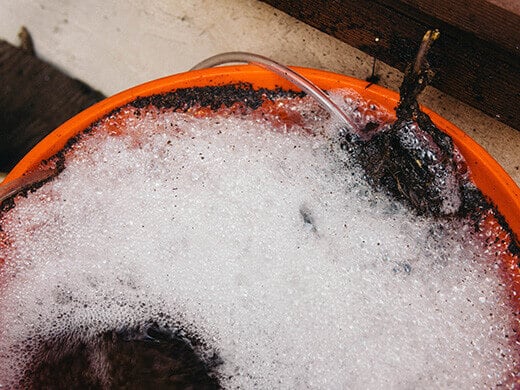
The next day, preferably in the early morning or late afternoon when the sun is off your plants, turn off the pump and remove the burlap sack and stones.
The compost tea should smell fresh and earthy, like a forest floor. If it smells off (a sign of your compost going anaerobic), discard it and start again.
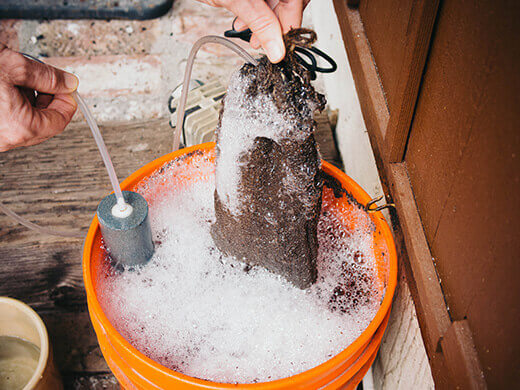
At this point you have an active, living, breathing thing in that bucket, so it’s best to use the compost tea immediately. Never let it stagnate for more than four hours (less if it’s very warm) and never try to store unused tea.
How to Use Your Compost Tea
Compost tea can be applied as a soil drench or foliar spray at a dilution rate of 1:5 to 1:10, compost tea to dechlorinated water.
The beauty of an actively aerated compost tea is that it’s impossible to overdo it the way you can with a synthetic fertilizer or even another natural fertilizer; you cannot burn the leaves with an overzealous treatment. But, you won’t necessarily reap more of the benefits by adding an entire bucket to a bed.
As a soil drench, you can pour it on the ground full-strength, especially if you’re trying to build up a new season of soil or you’ve just solarized your garden. This is ideal in spring and fall before your seeds or transplants go in the ground.
As a foliar spray, I use a 1:5 dilution for growing plants and a 1:10 dilution for seedlings. On plants that may be stressed or newly transplanted, I use a 1:1 dilution.
As you can see, there’s no standard for usage and you merely use your best judgment based on the needs of your plants. A 5-gallon bucket can go quite a long way.
With a foliar spray, it’s especially important that you shower your plants when the sun is weakest, typically before 9 am or after 3 pm. Ultraviolet rays kill microbes, even on cloudy days. I use a watering can to spray the diluted compost tea over and under the leaves.
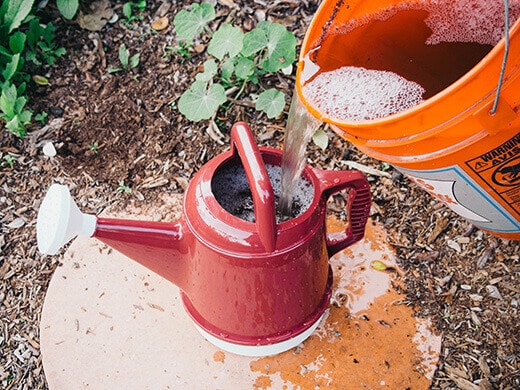

The key to skipping the extra step of straining compost tea is using a watering can with relatively large holes, which prevent any particulates from clogging the spout (a problem I had with my previous watering can, which you can see side by side here with my current one).
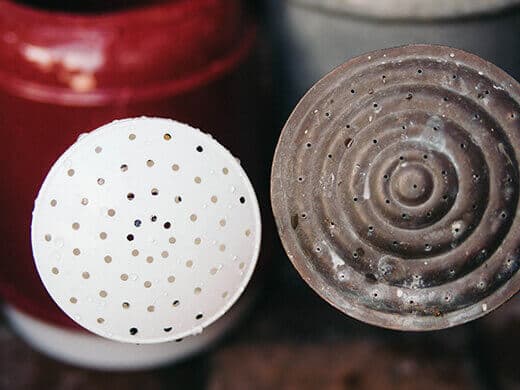

It’s also suggested in the book Teaming with Microbes that a foliar spray should have a drop diameter of at least 1 millimeter, effectively allowing the bacteria to develop enough slime to establish themselves before the water evaporates.
Use the compost tea on not only your garden beds, but also your containers and even your houseplants, every two to three weeks. If you’re feeling especially motivated, you can even apply the compost tea to your plants once a week to get them going.
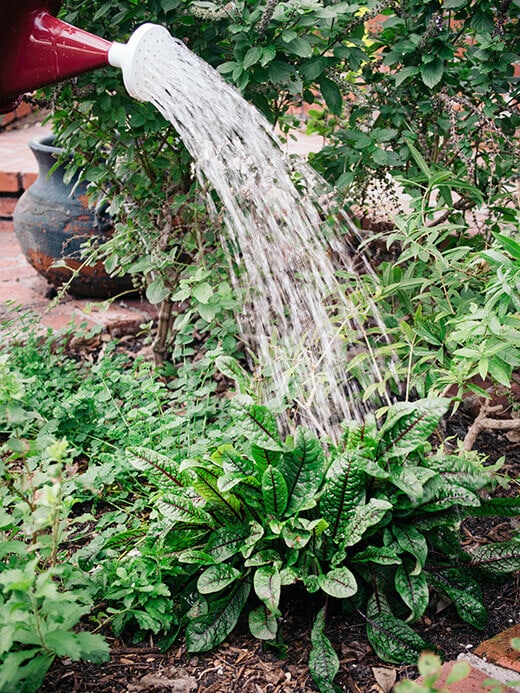
Once you’ve emptied the bucket, scrub it clean to remove any biofilm clinging to the surfaces; same goes for the air stones and hoses.
Toss any remaining compost in the burlap sack onto your soil, then rinse it with water and dry in the sun. A successful brew always begins and ends with clean equipment.
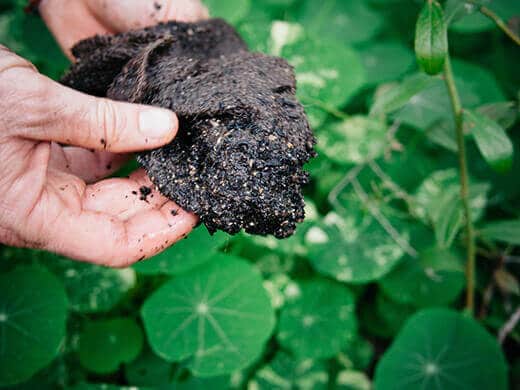
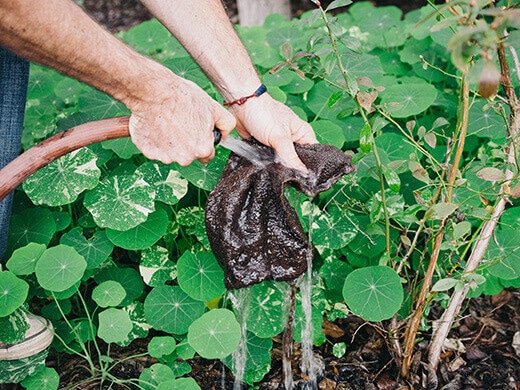
Compost Tea Brewing Sources
[show_shopthepost_widget id=”3781972″]


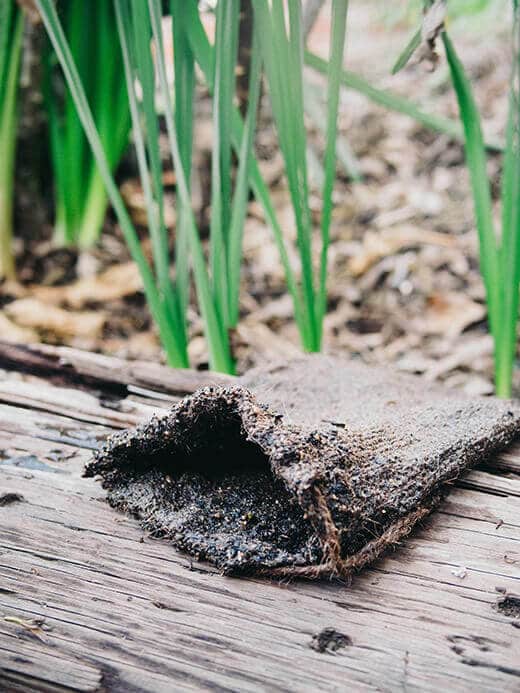













I have it on good authority that tomatoes prefer a fungal dominated environment. My source is Matt Slaughter, the CEO of Earthfort
Hi Linda! Thanks for the article, I’ve only discovered your site recently. Just a question with the application of your AACT, if you’re diluting it to 1:10 with dechlorinated water, that will give you 50 gallons, or roughly 200L. Given a standard watering can size, you’d have to apply over 22 full watering cans within four hours of making the tea to use it all up. This sounds like a lot of work, and furthermore, depending on the size of the garden, too much water to be applying to water plants in one hit. (I’m new to gardening so our garden space is still relatively small). Am I missing something here, or is there a quicker/easier way to apply the tea? Thanks!
There’s no right or wrong way to apply compost tea. You can use it full-strength (no dilution) as a soil drench, especially on new beds or new soil. Or, you can dilute 1:5 for growing plants, 1:10 for seedlings, and 1:1 for stressed or newly transplanted plants. The compost tea can be applied to the soil or used as a foliar spray and you can use it on flowers, herbs, and fruit trees as well, not just your vegetables. If you have any compost tea left over, you can use it to moisten a compost pile or leaf pile (to help it break down faster)—use just enough to make it damp like a wrung-out sponge, not soaking wet.
Charlie Bourgeois liked this on Facebook.
Laurie Smith liked this on Facebook.
Kindra RH liked this on Facebook.
Will Taylor liked this on Facebook.
Mike C Podlesny liked this on Facebook.
Brittney Bennett liked this on Facebook.
Kristin Joanna Chapin liked this on Facebook.
Amy Goo liked this on Facebook.
Sarah Grace Slater liked this on Facebook.
Diana Heffernan-Schrader liked this on Facebook.
Angie Smith liked this on Facebook.
Tina Michael liked this on Facebook.
Marjorie Pitts liked this on Facebook.
Michael D Doss liked this on Facebook.
Natasha Winterrose liked this on Facebook.
Jeremy Conyers liked this on Facebook.
How often do you apply the “tea” to your garden.
Usually twice a month. I start as soon as the seedlings are a few weeks old (at a more dilute strength).
Thanks! 🙂
Brewing Compost Tea for Better Plant Health http://t.co/dg4wbzID2u #gardenchat < TY for RT! @DefinitelyLisa @Permaculture123 @ModernSteader
Making a batch every week is effortless with @BoogieBrew. Brewing Compost Tea for Better Plant Health http://t.co/rICoQ3W1tE #gardenchat
RT @theGardenBetty: Revive and replenish the soil food web in your garden. Brewing Compost Tea for Better Plant Health http://t.co/dg4wbzID…
@Lil_King76 @Mike52Owens you 2 gents might find this interesting: http://t.co/q5DcmZ5FOl
RT @theGardenBetty: Revive and replenish the soil food web in your garden. Brewing Compost Tea for Better Plant Health http://t.co/dg4wbzID…
RT @theGardenBetty: Revive and replenish the soil food web in your garden. Brewing Compost Tea for Better Plant Health http://t.co/dg4wbzID…
Revive and replenish the soil food web in your garden. Brewing Compost Tea for Better Plant Health http://t.co/dg4wbzID2u #gardenchat
Improve your soil biology for spring planting. Brewing Compost Tea for Better Plant Health http://t.co/N8nbF2xICa #gardenchat
Yes, you can make compost tea without your own compost. Brewing Compost Tea for Better Plant Health http://t.co/eZORgBAfIy #gardenchat
I absolutely love compost tea … I also love using manure tea as well in my garden. Both help tremendously with increasing microbe activity and contribute to overall plant health. Great article!!
I’m experimenting with manure tea for the first time using fresh chicken manure, but there are a lot of conflicting instructions on the web regarding brewing time & safety. what method do you use?
Manure tea is a type of compost tea, but it’s not the same as the actively aerated compost tea (AACT) that I brew in this post. AACT is made from non-manure compost. I don’t recommend aerating manure compost as that could potentially multiply the pathogens in the manure. For my own chicken manure, I simply spread it on my soil as a side dressing.
Great thank you for the info. Just one more question – how long do you age the manure for?
It depends on how hot your manure gets, but generally I age mine for about 6 months.
I don’t use the aeration method with animal manure, I simply steep it in water for 24 hours … I also use only aged manure … I either use my chicken manure or a product called Authentic Haven Brand manure tea … the manure comes from grass fed beef in California
Thank you!
Brewing Compost Tea for Better Plant Health | Garden Betty http://t.co/NVoiJW3YWB
Considering the ingredients are from all over the country, I am not sure I would have confidence in the quality of the product or that it is truly organic. Beyond that, it seems that requiring the set up of a brew station with an electric pump, controlling temperatures and such is not sustainable and a lot of tedious, unnecessary work. I think I will stick with manure tea.
All the ingredients may not be California-based, but they’re from small companies where quality control is easier to maintain. The benefit of small companies is that you can always call them up with any concerns.
As for the brew station, that is typical of making any actively aerated compost tea (AACT). You need aeration to stimulate the microbes. It’s not tedious at all since everything you need comes in the Boogie Brew Kit. But if you were to use another brand, sourcing the equipment is not difficult as they are common in gardening. Manure tea has its own (very different) benefits, so it’s not the same type of fertilizer as AACT.
Julie,
We should consider the amount of work going into the raising of stock animals, including seeding up the pastor, raising stock, grazing stock, biological work done by the animal to create the manure, etc.. Not to mention the concern of pathogens including e. coli.
Boogie Brew is veganic and while the human race may have not perfected a harmonious system to curb hunger, this is an excellent, ethical and efficient way of growing your greens!
RT @theGardenBetty: How I make a soil drench and foliar spray with @BoogieBrew. Brewing Compost Tea for Better Plant Health http://t.co/avD…
How I make a soil drench and foliar spray with @BoogieBrew. Brewing Compost Tea for Better Plant Health http://t.co/avDMDHoa64 #gardenchat
Great article. Have you learned in your studies of composting that it would be better to use locally sourced materials or would Pacific Northwest compost work for a grower in Florida for example?
I’ve read that it’s actually beneficial to introduce new microorganisms to your garden; for example if you wanted to increase fungal activity, you could add forest soil to your compost. As long as the compost is properly aged, I don’t believe local has an advantage over non-local, other than supporting a local economy.
Shit is shit unless it doesn’t come from an anus.
Blogged on Garden Betty: Brewing Compost Tea for Better Plant Health http://t.co/uAzIIiRhOa